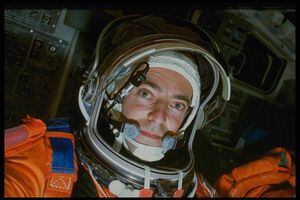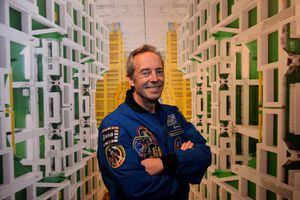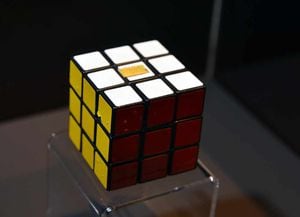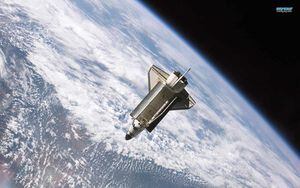From space to Wolverhampton: An astronaut with his feet firmly on the ground
He's spent a total of 675 hours out of this world on three missions orbiting the globe 439 times and travelling 113 million miles.

But down-to-earth astronaut Jean-François Clervoy insists he did not return from outer space a changed man and that his feet are still firmly on the ground.
And he revealed after a less dramatic journey to Wolverhampton: "I do not think space travel has ever profoundly changed what a person was.
"That theory came from people looking for something dramatic when they interviewed those who first went to the moon.
"Like any extreme adventure, such as climbing Everest, you return enriched with more memories, more experiences and more stories to tell. But it does not alter your character or beliefs."
Jean-François continued: "The view from space makes you appreciate how fragile life on earth is. You realise that we depend on a thin layer of gas to breath. The atmosphere looks as thin as a cigarette paper and our life depends on it.
"That makes you ask questions you have never done before and reflect more deeply. You have the privilege of relating your thinking to your experience in space whether that is spiritual or something else."
He flew twice on Space Shuttle Atlantis and once aboard Discovery between 1994 and 1999. He deployed a research satellite on the first trip, was payload commander of the second during which he operated the system that docked the Atlantis shuttle with the Russian Space Station Mir. He was also in charge of the transfer of four tons of equipment and coordinated more than 20 experiments.
Jean-Francois' final journey into space was an eight-day mission on Discovery during which the crew successfully installed new instruments and upgraded systems on the Hubble Space Telescope. He was the flight engineer and used the robot arm to capture and deploy the telescope and manoeuvre fellow astronauts on space walks.
He trained as a test engineer, was selected as an astronaut in 1985 and had intensive Russian language training. In 1991 he trained in Star City, Moscow on the Soyuz and Mit systems and became a member of the European Space Agency corps the following year.
The astronaut was at Wolverhampton Art Gallery to launch its Spring Programme that includes three shows related to space, one of which is entitled 'The Poetic Impossibility to Manage the Infinite.'
This is the work of Portuguese photographer Edgar Martins whose pictures were taken during unique access to all aspects of the European Space Agency. The exhibition shows images taken from 15 locations across the world, including test centres, robotics departments and space simulators.
They form a fascinating exhibition that runs at Wolverhampton Art Gallery in Lichfield Street until May 2. Its curator Miss Neus Miro said: "You can look at these photographs and lose yourself in a world of imagination."
During the project Edgar met and became friends with Jean-François who paused to give a fascinating insight into the life of the astronaut during his visit to the show.
He told how 70 per cent of the training was conducted in a flight simulator where the crew were constantly challenged by problems that had increasingly difficult solutions.
Married father of two Jean-François from Toulouse explained: "The instructors could not give us a scenario without a solution but they come up with some very nasty ones. You have to manage the problem and decide which malfunction to correct first. You become a problem solver and develop a belief that every problem has a solution. It makes you think positively.
"You imagine there will be a failure all the time but are always sure that there will also be a solution. You must be rational and not emotional in the way you respond to a crisis and develop an ability to control yourself in stressful situations."
He is the original action man enjoying racquet sports, canyoning, skiing and enjoys hobbies such as flying boomerangs, Frisbees and kites. But none of these can comapre to space travel.
Jean-François said: "When men went to the moon 40 years ago they saw the earth like a golf ball but only around 20 of the 538 people who have been into space went to the moon. That is 1000 times further than the Space Station that I went to.
"You cannot see the whole hemisphere of earth from where I was. You just see 2,500 km stretches at a time but are travelling at 28,000km-an-hour and do a full tour every 90 minutes.
"That means the sun sets or rises every 45 minutes and you go from winter to summer in the same period of time. The earth is very colourful with forests, deserts, glaciers, oceans and volcanoes clearly visible. It is like a spinning ball.The sight of such a wide variety of colours changing so fast is both beautiful and very moving.
"You see the earth, the sun and the moon but the rest is the black ink of the cosmos. You think you are alone in the universe, there is nothing else other than you and your crew and there is no one to help you."
The astronaut is allowed to take three items that can be touched during the flight. His included a picture of his family and a Rubik cube to play with before falling asleep. This inspired film director AlfonsoCuaron to include a shot of a Rubik cube floating passed actress Sandra Bullock during a scene in the Oscar nominated space film Gravity.
Jean-François also took a notebook in which were jotted the things an experienced astronaut had told him not to forget to do on the mission because he did not want to come back with regrets.
Top of the list was to switch off the cockpit to see the stars in space when on the night side of earth. "Don't call it the dark side or people will think of Darth Vader," warned Jean-François with a smile before adding: "When your eyes get used to the dark you see billions of stars. They don't twinkle because you are not looking at them through the atmosphere but it makes you realise you are not alone after all."
Astronauts can also take 20 items - normally small keepsakes like rings or a watch - stored in a one litre holdall which cannot be touched in flight but can later be authenticated as having travelled millions of miles in space. The astronauts are also encouraged to take as many pictures as possible.
Not everything went perfectly for the fluent Russian speaking Frenchman high above the earth. He taught the rest of his crew the words to the Russian Cosmonaut Song for their journey to the Mir space station.
Jean-François recalled: "We intended to sing it as the hatch was closed for the last time before we returned home but were so moved and sad that we forgot. When we were around 400ft away we realised our mistake and sang it down the radio for the ground crew instead. They told us to stick to our day job."










